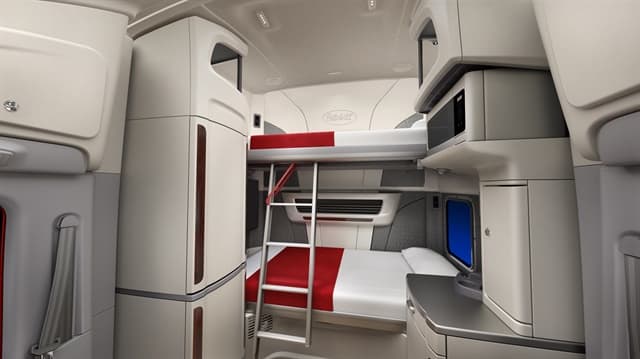Everyone knows by now that the Federal Motor Carrier Safety Administration has officially published the long-awaited Notice of Proposed Rulemaking Hours of Service of Drivers.
The initial document made public contained 129 typewritten, double-spaced pages, so it’s unlikely that very many have read it in its entirety.
For those who think the FMCSA never listens to industry stakeholders, take heed.
The split-duty provision is the result of stakeholder input.
Part of the document contains a discussion for each of the major changes, including the split-duty provision, which allows a driver to take up to a three-hour break and extend the 14-hour on-duty window.
Here’s the way the provision now reads as taken from the FMCSA document:
 “After being off duty for 10 or more consecutive hours, a driver of a property-carrying CMV is allowed a period of 14 consecutive hours in which to drive up to 11 hours. The 14-consecutive-hour driving window begins when an individual starts any kind of work. The individual may not drive again after the end of the 14-hour window until he or she has been off duty for another 10 consecutive hours, or the equivalent of at least 10 consecutive hours using the sleeper berth option. This 14-hour window currently may not be extended by off-duty breaks that may occur during the duty period.”
“After being off duty for 10 or more consecutive hours, a driver of a property-carrying CMV is allowed a period of 14 consecutive hours in which to drive up to 11 hours. The 14-consecutive-hour driving window begins when an individual starts any kind of work. The individual may not drive again after the end of the 14-hour window until he or she has been off duty for another 10 consecutive hours, or the equivalent of at least 10 consecutive hours using the sleeper berth option. This 14-hour window currently may not be extended by off-duty breaks that may occur during the duty period.”
Here’s the new proposal per the same document:
“Would add a new option for one off duty break of at least 30 minutes, but no more than three hours, during the course of a driver’s 14-hour driving window to extend the 14-hour driving window to extend that period for the length of that break, provided that drivers take at least 10 consecutive hours off at the end of the work shift.”
According to the FMCSA document, it was the Owner-Operator Independent Drivers Association that petitioned the FMCSA to change the rule to allow extending the 14-hour driving window.
Speaking to comments that were requested when the Advance Notice of Proposed Rulemaking was published in August 2018, consistent with the OOIDA petition, the FMCSA said a number of commenters addressed the 14-hour rule, saying that it should be extended by a break period of up to three hours.
“Many commenters to the ANPRM have stated that the 14-hour driving window does not comport with the inconsistent and sometimes unpredictable working conditions encountered during a duty period. Thus, the current rule leads to unintended consequences of added stress and potential speeding that result from the need to finish a run prior to the end of the 14-hour window.
Just because the split-duty provision is in the NPRM, doesn’t mean it will be in the final rule.
Safety advocates could mount a successful campaign to prevent inclusion.
To wit, the FMCSA is seeking comments on specific questions related to the split-duty provision.
If you like this provision, you should comment.
Among the questions:
- How will this provision impact the number of driving hours during a single driving window?
- How will this provision impact your total driving hours during a given week or year?
- How would this provision impact your regular schedule? How often would you expect to take advantage of this provision in a given work week? Why?
- What are the expected benefits from utilizing the 3-hour pause?
- Do you expect to use this provision to account for uncertainty so that trips could be finished on their scheduled completion day? How often do uncertain factors impact your schedule such that you are unable to complete a trip during the expected driving window and must delay delivery until after a 10-hour off-duty period?
- Do you expect to be able to complete more trips due to this provision (i.e., schedule additional freight movement)? How many additional trips would you expect to plan during a given week or year?
- Would you expect to be able to utilize more of the 11 hours of drive time currently available due to the three-hour pause?
- Do you expect this provision to impact drivers’ sleep schedule? How so?
- Will this provision allow for drivers to shift their circadian rhythms more easily than under current rules?
- In a full year, would this provision lead to additional driving miles and/or driving time?
- How often would you take advantage of the full three-hour pause as compared to shorter amount of time? Why?
- How would you plan to utilize the off-duty time spent during the three-hour pause?
- Would you utilize the time sleeping in a truck cab more often or other leisure activities more often?
- Do you anticipate any fatigue impacts on driving up to the 17th hour of a duty day?
- How would the up to three-hour break impact that fatigue level?
It’s important for you to comment, and the easiest method is to go to regulations.gov and type in FMCSA-2018-0248 in the search box. Hit the search button and a page will come up with a button on the righthand side that says “Comment Now.”
Lyndon Finney’s publishing career spans over 55 years beginning with a reporter position with the Southwest Times Record in Fort Smith, Arkansas, in 1965. Since then he’s been a newspaper editor at the Southwest Times Record, served five years as assistant managing editor of the Arkansas Democrat-Gazette in Little Rock and from November 2004 through December 2019 served as editor of The Trucker. Between newspaper jobs he spent 14 years as director of communications at Baptist Health, Arkansas’ largest healthcare system. In addition to his publishing career he served for 46 years as organist at Little Rock’s largest Baptist church.








